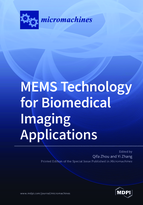MEMS Technology for Biomedical Imaging Applications
A special issue of Micromachines (ISSN 2072-666X). This special issue belongs to the section "A:Physics".
Deadline for manuscript submissions: closed (30 August 2018) | Viewed by 69318
Special Issue Editors
Interests: MEMS; biomedical imaging; photoacoustic imaging; ultrasound; elastography
Special Issues, Collections and Topics in MDPI journals
Special Issue Information
Dear Colleagues,
Biomedical imaging is the key technique and process to create informative images of the human body or other organic structures for clinical purposes or medical science. Micro-electro-mechanical systems (MEMS) technology has demonstrated enormous potential in biomedical imaging applications due to its outstanding advantages of, for instance, miniaturization, high speed, higher resolution, and convenience of batch fabrication. There are many advancements and breakthroughs developing in the academic community, and there are a few challenges raised accordingly upon the designs, structures, fabrication, integration, and applications of MEMS for all kinds of biomedical imaging. This Special Issue aims to collate and showcase research papers, short commutations, perspectives, and insightful review articles from esteemed colleagues that demonstrate: (1) original works on the topic of MEMS components or devices based on various kinds of mechanisms for biomedical imaging; and (2) new developments and potentials of applying MEMS technology of any kind in biomedical imaging. The objective of this special session is to provide insightful information regarding the technological advancements for the researchers in the community.
Prof. Dr. Qifa Zhou
Dr. Yi Zhang
Guest Editors
Manuscript Submission Information
Manuscripts should be submitted online at www.mdpi.com by registering and logging in to this website. Once you are registered, click here to go to the submission form. Manuscripts can be submitted until the deadline. All submissions that pass pre-check are peer-reviewed. Accepted papers will be published continuously in the journal (as soon as accepted) and will be listed together on the special issue website. Research articles, review articles as well as short communications are invited. For planned papers, a title and short abstract (about 100 words) can be sent to the Editorial Office for announcement on this website.
Submitted manuscripts should not have been published previously, nor be under consideration for publication elsewhere (except conference proceedings papers). All manuscripts are thoroughly refereed through a single-blind peer-review process. A guide for authors and other relevant information for submission of manuscripts is available on the Instructions for Authors page. Micromachines is an international peer-reviewed open access monthly journal published by MDPI.
Please visit the Instructions for Authors page before submitting a manuscript. The Article Processing Charge (APC) for publication in this open access journal is 2600 CHF (Swiss Francs). Submitted papers should be well formatted and use good English. Authors may use MDPI's English editing service prior to publication or during author revisions.
Keywords
- MEMS for optical imaging
- MEMS for ultrasound transducer and imaging
- MEMS for photoacoustic imaging
- MEMS for thermal imaging








